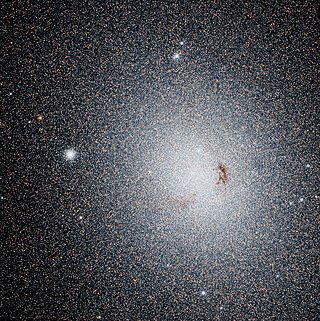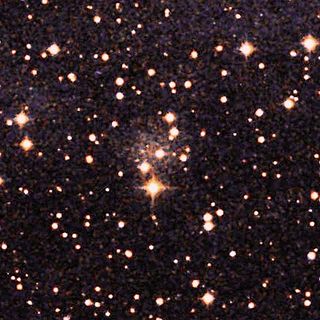| Andromeda XI | |
|---|---|
| Observation data (J2000 epoch) | |
| Constellation | Andromeda |
| Right ascension | 00h 46.3m [1] |
| Declination | +33° 48′ 05″ [1] |
| Redshift | -0.001399 ± 0.000015 [1] |
| Heliocentric radial velocity | (-419 ± 4.4) km/s [1] |
| Distance | 2.6 ± 325 Mly (830 kpc) [2] |
| Absolute magnitude (V) | −7.3 [3] |
| Characteristics | |
| Type | dSph D [1] |
| Apparent size (V) | 0.5 arcmin [4] |
| Notable features | satellite galaxy of the Andromeda Galaxy |
| Other designations | |
| And XI, PGC 5056923 | |
Andromeda XI (And 11) is a dwarf spheroidal galaxy about 2.6 million light-years away from the Sun [2] in the constellation Andromeda. [4] Discovered in 2006, [2] And XI is a satellite galaxy of the Andromeda Galaxy (M31).

The Local Group is the galaxy group that includes the Milky Way, where Earth is located. It has a total diameter of roughly 3 megaparsecs (10 million light-years; 9×1019 kilometres), and a total mass of the order of 2×1012 solar masses (4×1042 kg). It consists of two collections of galaxies in a "dumbbell" shape; the Milky Way and its satellites form one lobe, and the Andromeda Galaxy and its satellites constitute the other. The two collections are separated by about 800 kiloparsecs (3×106 ly; 2×1019 km) and are moving toward one another with a velocity of 123 km/s. The group itself is a part of the larger Virgo Supercluster, which may be a part of the Laniakea Supercluster. The exact number of galaxies in the Local Group is unknown as some are occluded by the Milky Way; however, at least 80 members are known, most of which are dwarf galaxies.

Andromeda is one of the 48 constellations listed by the 2nd-century Greco-Roman astronomer Ptolemy, and one of the 88 modern constellations. Located in the northern celestial hemisphere, it is named for Andromeda, daughter of Cassiopeia, in the Greek myth, who was chained to a rock to be eaten by the sea monster Cetus. Andromeda is most prominent during autumn evenings in the Northern Hemisphere, along with several other constellations named for characters in the Perseus myth. Because of its northern declination, Andromeda is visible only north of 40° south latitude; for observers farther south, it lies below the horizon. It is one of the largest constellations, with an area of 722 square degrees. This is over 1,400 times the size of the full moon, 55% of the size of the largest constellation, Hydra, and over 10 times the size of the smallest constellation, Crux.

The Pegasus Dwarf Spheroidal is a dwarf spheroidal galaxy about 2.7 million light-years away in the constellation Pegasus. The Pegasus Dwarf is a member of the Local Group and a satellite galaxy of the Andromeda Galaxy (M31).

Messier 110, or M110, also known as NGC 205, is a dwarf elliptical galaxy that is a satellite of the Andromeda Galaxy in the Local Group.

NGC 185 is a dwarf spheroidal galaxy located 2.08 million light-years from Earth, appearing in the constellation Cassiopeia. It is a member of the Local Group, and is a satellite of the Andromeda Galaxy (M31).
Andromeda IX is a dwarf spheroidal satellite of the Andromeda Galaxy. It was discovered in 2004 by resolved stellar photometry from the Sloan Digital Sky Survey (SDSS), by Zucker et al. (2004). At the time of its discovery, it was the galaxy with the lowest known surface brightness, ΣV ≃ 26.8mags arcsec−2 and the faintest galaxy known from its intrinsic absolute brightness.

Andromeda II is a dwarf spheroidal galaxy about 2.22 Mly away in the constellation Pisces. While part of the Local Group, it is not quite clear if it is a satellite of the Andromeda Galaxy or the Triangulum Galaxy.
Andromeda III is a dwarf spheroidal galaxy about 2.44 million light-years away in the constellation Andromeda. It is part of the Local Group and is a satellite galaxy of the Andromeda Galaxy (M31). The galaxy was discovered by Sidney van den Bergh on photographic plates taken in 1970 and 1971.

Andromeda IV is an isolated irregular dwarf galaxy. The moderate surface brightness, a very blue color, low current star formation rate and low metallicity are consistent with it being a small (background) dwarf irregular galaxy, perhaps similar to Local Group dwarfs such as IC 1613 and Sextans A. Arguments based on the observed radial velocity and the tentative detection of the RGB tip suggest that it lies well outside the confines of the Local Group.
Andromeda V is a dwarf spheroidal galaxy about 2.52 Mly away in the constellation Andromeda.

The Cassiopeia Dwarf (also known as Andromeda VII) is a dwarf spheroidal galaxy about 2.45 Mly away in the constellation Cassiopeia. The Cassiopeia Dwarf is part of the Local Group and a satellite galaxy of the Andromeda Galaxy (M31). In the sky, it appears behind the Milky Way's galactic plane, and so it is reddened by 0.194 magnitudes. With a luminosity of 1.8×107 L☉ and a stellar mass of 19.73×106 M☉, it is the brightest and most massive of the Andromeda Galaxy's dwarf spheroidal galaxy satellites. It also has the highest metallicity out of all of them.

IC 342 is an intermediate spiral galaxy in the constellation Camelopardalis, located relatively close to the Milky Way. Despite its size and actual brightness, its location behind dusty areas near the galactic equator makes it difficult to observe, leading to the nickname "The Hidden Galaxy", though it can readily be detected even with binoculars. If the galaxy were not obscured, it would be visible by naked eye. The dust makes it difficult to determine its precise distance; modern estimates range from about 7 million light-years (Mly) to about 11 Mly. The galaxy was discovered by William Frederick Denning in 1892. It is one of the brightest in the IC 342/Maffei Group, one of the closest galaxy groups to the Local Group. Edwin Hubble first thought it to be in the Local Group, but it was later determined not to be a member.
Andromeda X is a dwarf spheroidal galaxy about 2.9 million light-years away from the Sun in the constellation Andromeda. Discovered in 2005 by Zucker et al., And X is a satellite galaxy of the Andromeda Galaxy (M31). Aided by the application of stellar photometry to data from the Sloan Digital Sky Survey similar to the Andromeda IX discovery, the new finding indicates that this type of extremely faint satellite might be common in the Local Group, potentially providing further support for hierarchical cold dark matter models.
Andromeda XXI is a moderately bright dwarf spheroidal galaxy about 859 ± 51 kiloparsecs (2.80 ± 0.17 Mly) away from the Sun in the constellation Andromeda. It is the fourth largest Local Group dwarf spheroidal galaxy. The discovery arose from the first year data of a photometric survey of the M31/M33 subgroupings of the Local Group by the Pan-Andromeda Archaeological Survey (PAndAS). This survey was conducted with the Megaprime/MegaCam wide-field camera mounted on the Canada-France-Hawaii Telescope.
Andromeda XXII is a low surface brightness dwarf spheroidal galaxy about 940–1,033 kiloparsecs away from the Sun in the constellation Pisces, of the Local Group.
Andromeda XIX is a satellite galaxy of the Andromeda Galaxy (M31), a member of the Local Group, like the Milky Way Galaxy. Andromeda XIX is considered "the most extended dwarf galaxy known in the Local Group", and has been shown to have a half-light radius of 1.7 kiloparsec (kpc). It was discovered by the Canada–France–Hawaii Telescope, and is thought to be a dwarf galaxy.

Andromeda XVIII, discovered in 2008, is a dwarf spheroidal galaxy, which is a satellite of the Andromeda Galaxy (M31). It is one of the 14 known dwarf galaxies orbiting M31. It was announced in 2010 that the orbiting galaxies lie close to a plane running through M31's center.

Donatiello I, also known as Mirach's Goblin, is a dwarf spheroidal galaxy in the constellation Andromeda, located between 8.1 and 11.4 million light-years from Earth. It is a possible satellite galaxy of the dwarf lenticular galaxy NGC 404, "Mirach's Ghost", which is situated 60 arcminutes away. It is otherwise one of the most isolated dwarf spheroidal galaxies known, being separated from NGC 404 by around 211,000 light-years. The galaxy is named after its discoverer, amateur astronomer and astrophotographer Giuseppe Donatiello, who sighted the galaxy in a 2016 review of his archival long exposures from 2010 and 2013. Follow-up observations with the Roque de los Muchachos Observatory led to a scientific paper on its discovery being published in December 2018.